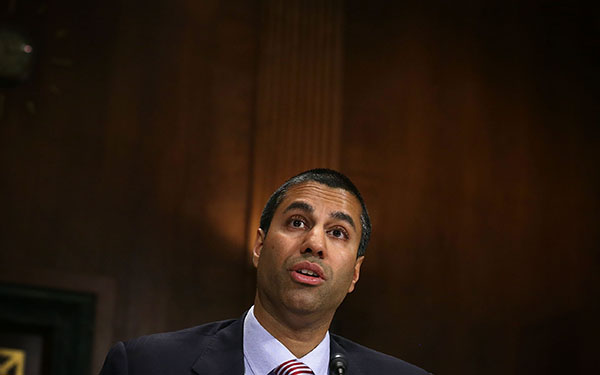Faster Internet at School: What’s Next for $4 Billion E-rate Fund Under New FCC Chief Ajit Pai?

Frankie Jackson likes to cut to the chase. When the veteran school business official took a new job as chief technology officer at the third-largest district in Texas a few years ago, one of the first things she did was ask her colleagues how much E-rate money was flowing in.
Not as much as there probably could be, she learned.
Jackson, like her counterparts in school districts throughout the country, raced to apply for the federal subsidy that would help get every school in the Cypress-Fairbanks district connected to wireless internet. It was 2015, and the Federal Communications Commission, which oversees the E-rate program, had just boosted the budget dedicated to wireless-related services while scaling back funding for other technology, like pagers and telephones, in a first-time effort to prioritize broadband expansion at schools and libraries.
Jackson said her district, which serves 115,000 students just outside of Houston, secured approval for wireless improvement and fronted the cost with $10 million from a district bond for technology projects, expecting to be reimbursed with the E-rate funds.
But two years later, despite assurances from the Universal Service Administrative Company, which manages the $4 billion E-rate program for the FCC, the district still hasn’t gotten its $10 million back, Jackson said in a recent interview.
“There’s a lot of red tape,” she said. “I understand they can’t just carte blanche hand over millions of dollars without going through the right level of accountability, but I’m still waiting.”
A rich history, literally
As many school officials can attest, the lag time between application, approval, and delivery of E-rate funds is just one of the long-standing problems that have plagued the program since it was established by the 1996 Telecommunications Act under President Bill Clinton.
E-rate is perhaps the largest federal funding stream dedicated to school technology, and among the largest school aid sources that doesn’t originate with the U.S. Department of Education.
Telecommunications companies are required by the 1996 law to fund E-rate and other federal programs boosting connectivity, but they’re allowed to pass the cost on to customers, meaning American consumers essentially bankroll the programs through a “universal service” fee on their phone bills.
The E-rate program for schools and libraries is just one of four programs supported with these fees to subsidize broadband and other telecommunications services managed by USAC and overseen by the FCC. The other three subsidize connectivity for households, rural health care facilities, and companies that build infrastructure in underserved areas. All told, the four programs account for at least $10 billion annually.
The results have been mixed. While E-rate is credited with helping transform school connectivity for millions of students, it’s also been dogged by abuse and fraud. Multiple congressional audits, meanwhile, have revealed weak internal controls and substantiated complaints that funds are frequently promised to applicants but never disbursed.
These days, few stakeholders seem more vexed by its track record than Ajit Pai, a Republican commissioner since 2012 who was promoted in January by President Donald Trump to lead the five-member panel, now under Republican control.
Pai hasn’t yet outlined a specific agenda for the multibillion-dollar program — instead, the debate over net neutrality, of which he is a staunch critic, has sucked up most of the oxygen in the few months since his appointment. But judging by the hints of policy the fiscal conservative and staunch deregulation proponent has revealed so far, he appears determined to shake things up significantly.


Federal Communications Commission Commissioner Ajit Pai testifies during a hearing before the Privacy, Technology and the Law Subcommittee of Senate Judiciary Committee on May 11, 2016 in Washington, D.C.
Photo: Getty Images
Piecing together Pai’s priorities
Pai, 44, is a longtime Washington attorney who grew up in rural Kansas, went to Harvard and then Chicago Law School, and has spent much of his career working in the public sector, where he has long advocated for expanding broadband access to rural communities.
As a member of the two-person Republican minority on the commission during the Obama administration, he was a consistently vocal critic of FCC decisions made by his predecessor, Chairman Tom Wheeler. Pai, too, will work to expand fast, reliable internet connections to schools, especially rural and low-income ones, but in a distinctly different manner than Wheeler.
The change in tone was on display in his first and only substantial remarks regarding E-rate since becoming chairman — in an April 18 letter to USAC CEO Chris Henderson that was subsequently posted on the FCC’s website. Pai urged Henderson to address technical problems and lack of transparency in the application and funding process that “have plagued schools and libraries for too long.”
Specifically, Pai directed USAC to resolve issues with the online system that all schools need to use to apply for funds. The system was supposed to be working by 2016. Today, the portal isn’t fully functional and has “created major headaches for applicants requesting E-rate funding,” Pai wrote, contributing to the backlog and, he suggested, to a drop-off in applicants. The $19 million project is over budget by at least $11 million and growing, he added.
“The E-Rate program is critical to the goals of universal service — it connects students and library patrons everywhere with digital opportunity,” Pai wrote. “But the program’s mission can be achieved only with proper administration. The problems I’ve identified have persisted and have plagued schools and libraries for too long; we must solve them, and soon.”
USAC is required to submit a plan of action by May 18. Officials there and at the FCC did not respond to multiple requests for comment. Through an FCC spokesman, Pai declined to be interviewed for this story.
The letter to USAC echoes Pai’s scathing assessments of past decisions by the commission when it was led by Democrats. In particular, his opposition in a 2014 party-line vote to overhaul E-rate through two “modernization orders” provides another indication of the chairman’s likely priorities in 2017 and beyond.
Among other changes, the orders were intended to remove a wrinkle in the way E-rate funds were previously distributed that resulted in voice calls, paging, and basic hardwired internet service (“Category 1”) being prioritized over wi-fi-related projects (“Category 2”).
Under the new rules, the commission raised the total annual spending cap from $2.4 billion to the current $3.9 billion, and dedicated $1 billion to Category 2 services including internal wireless connections. A phase-out of older Category 1 services produced some savings.
The changes ushered in a busy 2015 spring application season, with thousands of schools, like Cypress-Fairbanks in Texas, applying for funds to strengthen lackluster wireless systems or install them for the first time. According to a progress report published by the FCC in January just before Wheeler stepped down, 50,000 schools and libraries received wi-fi support in 2015, up from zero in 2013 and 2014. Previously, only 4 to 11 percent of schools and libraries that applied for Category 2 funds between 2008 and 2012 received them, the report states.
Delaware schools were among the beneficiaries of the overhaul and have since expanded wireless throughout its 19 public districts and 25 charter schools, said Kay Buck, who manages the state’s program.
“[In the past] our school districts were pretty reluctant to put the huge effort into applying for something that was never going to be funded and approved,” said Buck. The changes “caught the attention of many of our schools. … We weren’t going to let it pass us by.”
The reforms were the FCC’s response to a challenge Barack Obama laid out in a 2013 speech at Mooresville Middle School in North Carolina in which he called out the agency by name: “In a country where we expect free wi-fi with our coffee, why shouldn’t we have it in our schools? Right? Why wouldn’t we have it available for our children’s education?” the former president said.
But Pai said the commission hadn’t gone nearly far enough to carry out that bipartisan goal on behalf of the students, teachers, librarians, and parents it serves. He blasted the changes in a dissent statement, asserting that the FCC “fails to deliver real reform.”
“This order isn’t profound; it’s prodigal,” he wrote. “The commission shies away from making any hard choices and instead just pours more money into a broken system.”
He complained that the application process should be one page but remained long and complicated; and that the rural, remote, and poor schools that need reliable internet connections the most would be less likely to afford the consultants who are needed to manage the knotty application and appeals process.
He also argued that the funding increase would not be sustainable, asserting that “universal service” contribution rates from American consumers — essentially the phone bill fee that funds E-rate — have increased 60 percent between January 2009 and December 2014.
Fast-forward to January, and one of Pai’s first acts upon being promoted was the highly unusual retraction of Wheeler’s report touting the success of the program since the 2014 overhaul. The report will have “no legal or other effect or meaning going forward,” the FCC declared, though it remains available online. Education Week reported that an FCC spokesperson said the report “failed to follow proper procedures, and therefore, we can’t comment one way or the other on whether the findings and conclusions are accurate.”
Scandal
E-rate has been riddled with fraud and waste. In 2004, contractors working with Hewlett-Packard gave expensive gifts — including yacht trips and Super Bowl tickets — to officials from the Dallas and Houston school districts to win contracts for computer equipment that should have been awarded through competitive bidding, The New York Times reported. Hewlett-Packard paid $16 million in a settlement, most of which was returned to the E-rate fund.
Another widely reported investigation found that $5 million worth of equipment purchased by Chicago public schools with E-rate funds was left unused in a warehouse for years. Another instance of likely non-competitive bidding involved a charter network with schools in five states, including four in Chicago, that allegedly steered $5 million in E-rate funds to favored bidders.
An ongoing FBI investigation into possible fraud of E-rate funds in New York centers on several ultra-Orthodox Jewish schools in New York City and its suburbs that agents raided last spring, The Journal News reported. The insular religious communities served by those private schools typically prohibit internet use among their residents.
Still, success stories
In spite of its problems, the program is credited with transforming classroom connectivity — last year, 3,700 school districts upgraded their bandwidth and 40 percent of them did so at no additional cost, the advocacy group EducationSuperHighway found in its 2016 State of the States report. In all, 88 percent of public school districts now meet minimum connectivity targets established by the FCC, up from 30 percent in 2013, according to the report.
EducationSuperHighway, funded in large part by Mark Zuckerberg and the Bill and Melinda Gates Foundation, and other advocacy groups are working with governors in dozens of states to spur investment in broadband using E-rate. One method is setting up matching fund programs like one Arizona approved in March designed to cover what the federal subsidy does not.
Arizona’s program will provide $8 million over two years to cover the gap after E-rate funds up to 90 percent of rural schools’ broadband expansion costs, said Milan Eaton, the state’s E-rate consultant. An additional $5 million in the state budget would, if approved, bring the total state fund to $13 million.
A similar effort is under way in Connecticut, and several other states are considering establishing matching programs, according to EducationSuperHighway. New Mexico, California, Maine, Massachusetts, New York, North Carolina, and Oklahoma have already done so.
In the Socorro Independent School District, located along the Mexican border south of El Paso, Chief Technology Officer Hector Reyna said technology continues to be “a great equalizer” among his 46,000 students, including many low-income, migrant, and military children.
In 2015, the district used E-rate funds supplemented by local dollars to upgrade wireless connections at the elementary schools and middle schools; it started providing laptops to all incoming freshman and lends out portable wi-fi hotspots to kids who don’t have internet at home, Reyna said.
It also launched an extended-day academy for at-risk students featuring a digital curriculum. All participating students sign a contract and get a mobile device.
“We have seen [their] attendance go up, we have seen their grades go up, and most importantly we’ve seen their confidence go up,” Reyna said.
But he remains worried that Pai’s close ties to the private sector and swift steps this month to roll back Obama-era regulations on the telecommunications industry could bump up prices on future upgrades and tech services the district intends to fund with E-rate, however.
“Technology is great when you buy it, but the minute you install it, it’s old,” he said, adding that the data-rich assessments including videos and other interactive elements used by teachers require high speeds.
Get stories like these delivered straight to your inbox. Sign up for The 74 Newsletter

;)
